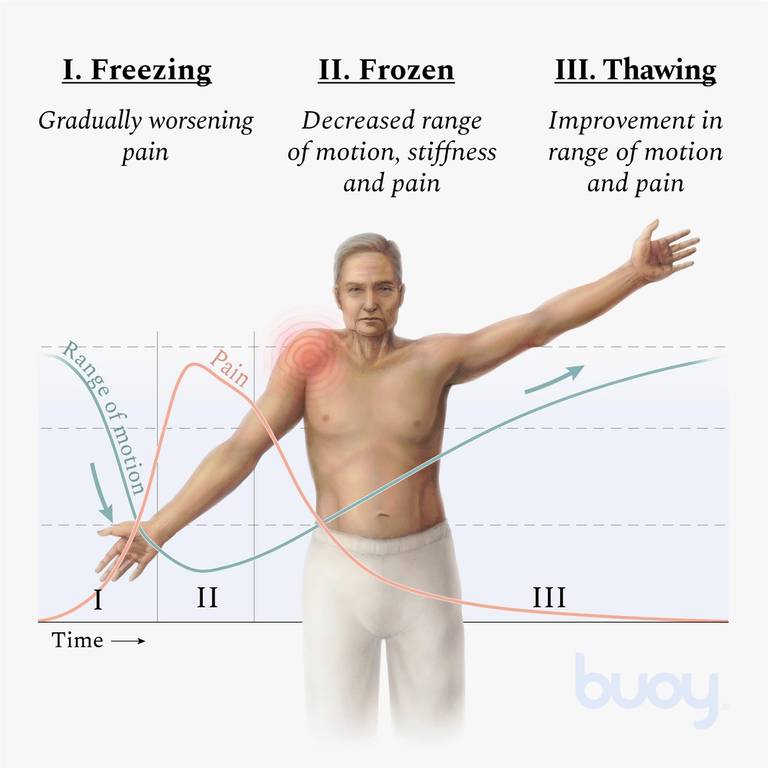A frozen shoulder, also called adhesive capsulitis, is a condition that causes pain and stiffness in the shoulder. The joint capsule becomes inflamed, limiting movement of the shoulder.
The condition often affects people with repetitive stress injuries to their shoulders, such as those who do many overhead activities or work with their arms out straight in front of them. It can also develop after an injury that strains the joint capsule, such as a fall or collision with another player during sports.
Symptoms
The main symptom of a frozen shoulder is pain and stiffness in your shoulder joint. The pain may become worse during movement and may affect your sleep. You may find lifting your arm behind your back or chest difficult.
The three stages of frozen shoulder

The three stages of frozen shoulder are:
Stage 1: Frozen Shoulder
The first stage of frozen shoulder can be experienced for 1-2 months after symptoms, although it may be longer. This stage is characterized by pain at rest and a reduced range of movement.
Stage 2: Frozen Shoulder with Partial Thawing
This stage occurs after the initial phase of the condition has passed and is characterized by a partial thawing in the shoulder’s joint capsule. This allows some movement in the joint, but not its full range of motion. The person may also experience mild stiffness and tenderness during this period.
Stage 3: Frozen Shoulder with Full Thawing
In this final stage of frozen shoulder, the pain has subsided, and most patients have a full range of motion in their shoulders again. Some patients may experience stiffness or tenderness in their shoulders, but this should be minimal and not cause any problems.
Causes of frozen shoulder
A frozen shoulder develops when something goes wrong with the ball-and-socket joint at the top of your upper arm bone in its socket joint at the top of your shoulder blade (scapula). This joint typically has a range of movement that allows you to move your arm freely in all directions without effort.
There are several ways to get rid of a frozen shoulder. The best way is to see your doctor. But if you want to try it at home first, here are some things that might help:
-
Heat
The heat helps relax the muscles that surround the joint. It also increases blood flow to the area and helps reduce inflammation. Heat therapy can be used in the following ways:
Hot packs or towels — Apply heat for 15 minutes at a time, four times a day. You can use moist heat by soaking a thin towel in warm water, wringing it out, and wrapping it around your painful shoulder. Or, you can apply an electric heating pad for 20 minutes at a time, two or three times daily.
Sauna — Spending 10 to 15 minutes in a steamy sauna several times weekly may help some people with frozen shoulders feel better. But don’t stay in too long — overheating can cause dehydration and heart problems in some people with heart disease or high blood pressure.
-
Stretching.
According to experts, stretching exercises can help improve flexibility in your muscles and tendons and increase blood flow through your joint. Try extending your arms overhead while lying on the floor or standing up against a wall while holding onto something for support (such as a towel rack). Hold each stretch for 30 seconds before moving on to the next, then repeat thrice daily.
-
Exercises.
Exercise helps improve range of motion and muscle strength in people with frozen shoulders who haven’t responded to other treatments. It’s important not to overdo it when exercising with a frozen shoulder — start slowly and progress gradually as your pain allows.
Physical therapists often recommend specific exercises that target different parts of your shoulder joint to increase flexibility and mobility in your affected arm and hand.
-
Medications
Nonsteroidal anti-inflammatory drugs (NSAIDs) reduce pain, inflammation, and thin mucus secretions that make it difficult to move your arm. They may also help relieve stiffness in your joints by blocking an enzyme called cyclooxygenase (COX), which produces prostaglandins (hormone-like chemicals that have essential roles in regulating inflammation).
-
Steroid Injections
Cortisone (a type of steroid) reduces inflammation by slowing the production of prostaglandins. However, it doesn’t help heal tissue damage or restore joint function as NSAIDs do. It’s most effective when used early on in the course.
-
Acupuncture
Acupuncture involves inserting needles into specific body areas to stimulate blood flow, ease pain and reduce inflammation.
While the shoulder is a complex joint with numerous muscles, tendons, and ligaments working together in a delicate balance, it can be challenging to determine which structures may be at fault when a frozen shoulder strikes.
Restoring a normal range of motion should be your primary concern as you slowly begin to stretch and manipulate affected muscles and tendons. Additionally, give your arms plenty of support while carrying out these exercises; this will help relieve pain and discomfort from the repetitive movements during daily living.
Taking frequent breaks from activities such as carrying bags or purses will also help to reduce the symptoms associated with frozen shoulder syndrome.





